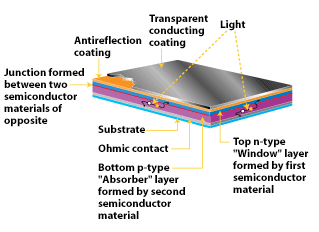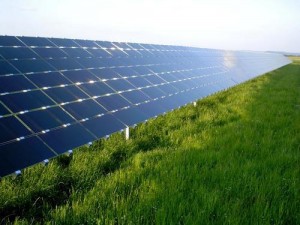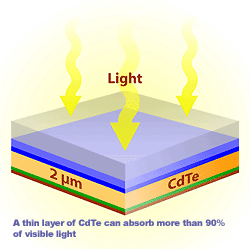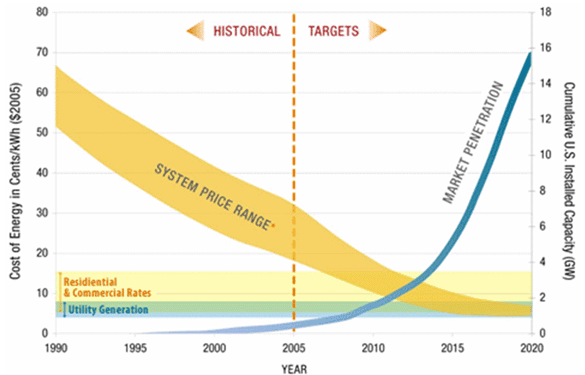Background:
Cadmium Telluride (CdTe), a member of the II-IV family of semiconductors, and is a good candidate for Thin-Film Photovoltaics (PV) because of its large optical absorption coefficient, its ability to be doped, and its near optimum band gap for solar energy conversion. Because of this large optical absorption coefficient, a CdTe film only needs to be 1-2 micrometers thick in order to absorb essentially 100% of the incident solar radiation. These thin-films can then be placed on numerous types of substrates such as plastic, metal, or glass; however the most commonly used substrate is soda-lime glass.
http://www.nrel.gov/pv/cdte/perspective.html
Figure 1: Schematic of a thin film CdTe Photovoltaic Cell. This picture illustrates where the photons are applied to the cell in relation to the layer of CdTe.
Efficiency:
Small area research type thin film PV cells based on CdTe have reached an efficiency of % 16.5 as show in the figure below, which makes them a plausible energy alternative to fossil fuels. Cadmium telluride-based modules are the lowest cost PV products available today (@ $0.73/Watt) and have reached efficiencies of 11.6%.
www.nrel.gov/pv/thin_film/docs/kaz_best_research_cells.pp
Figure 2: The Best Research Efficiencies of Solar Cells. This graph shows the efficiency of solar cells over time.
Material Properties:
Cadmium, which is a metal, is not directly mined. It is a by-product of copper and zinc mining. Over 8 million metric tons of zinc is produced every year, therefore it is a sustainable practice to incorporate the by-products from this process into photovoltaic cells instead of discarding it into the environment. Tellurium is also a by-product of copper mining. 50% of all Tellurium is produced in the United States. Tellurium and Cadmium are combined to form the molecule CdTe.
Construction:
Thin Film CdTe photovoltaic cells are manufactured via a variety of deposition techniques, including physical vapor deposition, chemical vapor deposition, close-spaced vapor transport, and Elemental Vapor Deposition a process currently being investigated at USF under NSF sponsorship.
Elemental Vapor Deposition Processing: Elemental vapors of Cd and Te are created by heating the elements at elevated temperatures. The vapors are transported using an inert gas and are allowed to condense onto a relatively low temperature substrate. This entire process occurs in approximately one minute’s time. The rate of the vapor deposition can be regulated by varying the temperature and pressure of the system.
http://rpmedia.ask.com/ts?u=/wikipedia/commons/e/e8/Illust_poly_thinfilm.gif
Figure 3: CdTe Thin Film Photovoltaic Cell. The layers of a cell from bottom to top are: substrate, ohmic contact, p-type layer, heterojunction, n-type layer, antireflective coating, and transparent conducting coating.
Feasibility and Pricing:
In addition, CdTe solar cells are attractive because they utilize only miniscule amounts of semiconductor materials, making them a realistic alternative to fossil fuel energy production. The average production cost for a CdTe PV module is approximately $0.73/watt, while more expensive silicon modules range from $1.70-2.00/watt. Prices for CdTe PV modules are expected to further decrease to prices in the $0.50-0.60/watt within the next two years. First Solar Inc., a US company, manufactures CdTe modules and is the world’s largest thin-film manufacturer.
http://www.thegreenfinance.org/wp-content/uploads/2010/12/20071026_cost-of-energy1.gif
Figure 4: The Cost of Thin Film Energy Over Time. As the price of CdTe thin-films drops, their popularity (market penetration) increases.
——————————-
References:
http://www1.eere.energy.gov/solar/pdfs/41736.pdf
http://www.electrochem.org/meetings/scheduler/abstracts/217/1178.pdf
http://ieeexplore.ieee.org/stamp/stamp.jsp?tp=&arnumber=347149
https://mailattachment.googleusercontent.com/attachment?ui=2&ik=797daac1b2&view=att&th=12dc92429b3c63cd&attid=0.1&disp=inline&realattid=ccd3ebfa46f39127_0.1.0&safe=1&zw&saduie=AG9B_P9r17SlOXqQ_B6arO5ydTPE&sadet=1302019862121&sads=NUwKcqQ0yTRtGJW5xYj-dRNLjgM&sadssc=1
http://www.nrel.gov/docs/legosti/fy97/21598.pdf




